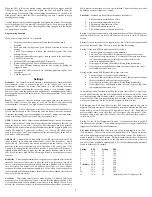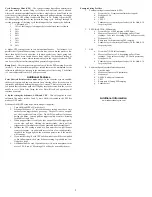
2
When the LED is lit for the desired setting, press and hold the trigger until the
LED goes out. When you release the trigger, the LED will blink to show the
current setting. For example, if the current setting for debounce is 5, the LED will
blink green 5 times. Once the LED stops blinking, you have 2 seconds to begin
entering the new setting.
To enter the new setting, pull the trigger the desired number of times. For example,
to set the debounce to 2, you must pull the trigger 2 times. Every time you pull the
trigger the LED will light. After all settings have been changed, turn the marker
off, using the power button.
Programming Example
If you want to set the dwell to 10, you should:
1.
Make sure the marker is powered off and the tournament lock is
disabled.
2.
Push and hold the trigger and press the power button to turn on the
marker.
3.
The LED goes through a rainbow, and then shows green. This is the
debounce mode.
4.
Quickly pull and release the trigger 1 time to switch to the dwell mode.
The LED will show red.
5.
Pull and HOLD the trigger until the LED turns off.
6.
Release the trigger. The LED will blink out the current setting.
7.
When the LED stops blinking, enter the new setting by pulling the
trigger 10 times.
8.
Wait until the LED turns back on, indicating programming has been
completed.
9.
Turn the marker off.
Settings
Debounce
– The Musashi software features a hybrid debounce scheme that uses
microcontroller cycles to debounce the pull of the trigger and ½ ms time
increments to debounce the release. This results in a very effective debounce
algorithm that does not hinder the user at any setting. At low debounce settings,
however, it may cause the marker to read switch bounce as additional pulls, falsely
generating shots or near full-automatic fire. The setting ranges from 1 to 50 and is
defaulted at 10.
Dwell
– The amount of time the solenoid is energized each time the marker is
fired. The default is 10 ms. The range is 5 to 20 ms. Too low of a dwell may lead
to inconsistency or drop off. Too high of a dwell can cause bad air efficiency.
Loader Delay
– Adds a slight delay after the eye has seen a ball and the bolt is
cycled, causing the gun to fire. If not using force fed loaders, it may be necessary
to increase this setting to prevent chopping. A setting of 1 means no loader delay,
which is the fastest. The default is 2 and may be set from 1 to 25.
AMB
– Allows the user to adjust the anti-mechanical bounce feature. Mechanical
bounce occurs with the Cyborg due to the kick generated during each shot and can
cause the marker to “run away,” firing even after the trigger has been released.
AMB helps stop markers from going full-automatic when the trigger is pulled very
slowly. The default is 2 and may be set from 1 to 5 (1 being off). AMB is only
used in fire modes 1 and 2 (semi-automatic unlimited and capped). In the PSP or
NXL modes AMB is disabled.
ARS Dwell
– Amount of dwell time added for an ARS (anti-ram stick) shot. The
range is from 1 to 10 additional milliseconds of dwell. The default is 1, which
turns ARS off. This feature may not be necessary with the Cyborg. It is only
necessary if the user is experiencing a low first shot. ARS is only used if the
Cyborg is left sitting idle for more than 20 seconds. The next shot will then have a
slightly higher dwell time to make sure the ram breaks free and there is no low
shot. Be aware that a high ARS dwell setting will lead to a much higher velocity
first shot.
Bolt Delay
– This setting determines how long the eyes are ignored after the dwell
time ends. Some delay is necessary to allow the bolt to get far enough forward so
the eye system does not mistake a small gap between a paintball and the bolt face
for a bolt return. The default is 10 ms and may be set from 1 to 20 ms. Higher
settings will reduce the maximum capable rate of fire, while lower settings may
lead to skipped or blank shots because the bolt does not have enough time to block
the eyes on its forward stroke.
Eye Mode
– This setting selects the eye mode. Setting 1 is delayed. In delayed
mode the eyes will watch for a ball up to ½ second after the trigger is pulled. After
½ second the marker will fire whether or not a ball is in the breech. If set to 2 (the
default), the eye mode is forced. In forced mode the marker will not fire unless a
ball is present in the breech or a force shot is utilized. The user can fire a force shot
by holding down the trigger for ½ second.
Fire Mode
– Included are five different fire modes (default is 1):
1.
Semi-automatic, unlimited rate of fire
2.
Semi-automatic, adjustable rate of fire
3.
PSP ramping, adjustable rate of fire
4.
PSP burst, adjustable rate of fire
5.
NXL full-automatic, adjustable rate of fire
Setting 1 is normal semi-automatic with an unlimited rate of fire while the eyes are
enabled. When the eyes are turned off, the max rate of fire is set to 20 balls per
second.
Setting 2 is semi-automatic with a capped rate of fire. It limits the maximum balls
per second that can be fired. The cap is set by the Max ROF setting.
Setting 3 is the first PSP fire mode that works as follows:
•
The first 3 shots of a string are semi-automatic.
•
After the 4
th
shot the marker will add shots as long as the user fires
faster than the ramp start setting. For example, if the ramp start setting
is 5, then the user must pull 5 times per second or faster for the
software to add additional shots.
•
If the trigger is released, the marker will stop firing immediately.
•
If the trigger is not pulled again within 1 second of release, the 3-shot
semi-automatic count starts over.
Setting 4 is the second PSP fire mode that works as follows:
•
The first 3 shots of a string are semi-automatic.
•
After the 4
th
shot the marker will fire 2 or more shots per pull as long as
the user continually pulls and releases the trigger.
•
If the trigger is released, the marker will stop firing immediately.
•
If the trigger is not pulled again within 1 second of release, the 3-shot
semi-automatic count starts over.
In normal operation, continually pulling the trigger faster than 5 to 6 pulls per
second will effectively give the user full-automatic at the max rate of fire. If the
user stops shooting then resumes within 1 second, the marker will return to the
max rate of fire. If the user stops shooting for more than 1 second, the next 3 shots
will be semi-automatic. On the 4
th
shot it will resume a faster fire rate.
PSP ramping and PSP burst differ in that PSP ramping requires the user to
maintain the ramp start rate of fire for software assistance, whereas the PSP burst
mode will fire at least 2 shots per pull, regardless of rate of fire. Some players
prefer multiple shots every time they pull the trigger after the initial 3 semi-
automatic shots, while others like to shoot 1 ball at a time until they achieve a
certain rate of fire.
Setting 5 is the NXL full-automatic fire mode. It functions similarly to the PSP
fire modes except, after the 3
rd
semi-automatic shot, the user may pull and hold the
trigger for the marker to fire in full-automatic.
Fire mode max rate of fire
– The max rate of fire setting applies to the 2nd –
12th fire modes. The max rate of fire is adjustable from 10 to 25 balls per second,
and has an unlimited setting for maxing out the loader system. The default is 7,
which is roughly 13 balls per second. Oscillator inconsistencies from chip to chip
make it impossible to time perfectly, so the only true way to check rate of fire is to
use a Pact Timer or ballistic chronograph. The red radar chronographs commonly
found at fields are NOT reliable.
Setting
BPS
Setting
BPS
1
10.0
12
15.5
2
10.5
13
16.0
3
11.0
14
17.0
4
11.5
15
18.0
5
12.0
16
19.0
6
12.5
17
20.0
7 (default) 13.0
18
21.0
8
13.5
19
22.0
9
14.0
20
23.0
10
14.5
21
24.0
11
15.0
22
Unlimited eyes on, 25.0 bps eyes off





















